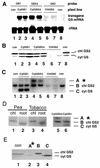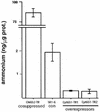Overexpression of cytosolic glutamine synthetase. Relation to nitrogen, light, and photorespiration
- PMID: 12114571
- PMCID: PMC166511
- DOI: 10.1104/pp.020013
Overexpression of cytosolic glutamine synthetase. Relation to nitrogen, light, and photorespiration
Abstract
In plants, ammonium released during photorespiration exceeds primary nitrogen assimilation by as much as 10-fold. Analysis of photorespiratory mutants indicates that photorespiratory ammonium released in mitochondria is reassimilated in the chloroplast by a chloroplastic isoenzyme of glutamine synthetase (GS2), the predominant GS isoform in leaves of Solanaceous species including tobacco (Nicotiana tabacum). By contrast, cytosolic GS1 is expressed in the vasculature of several species including tobacco. Here, we report the effects on growth and photorespiration of overexpressing a cytosolic GS1 isoenzyme in leaf mesophyll cells of tobacco. The plants, which ectopically overexpress cytosolic GS1 in leaves, display a light-dependent improved growth phenotype under nitrogen-limiting and nitrogen-non-limiting conditions. Improved growth was evidenced by increases in fresh weight, dry weight, and leaf soluble protein. Because the improved growth phenotype was dependent on light, this suggested that the ectopic expression of cytosolic GS1 in leaves may act via photosynthetic/photorespiratory process. The ectopic overexpression of cytosolic GS1 in tobacco leaves resulted in a 6- to 7-fold decrease in levels of free ammonium in leaves. Thus, the overexpression of cytosolic GS1 in leaf mesophyll cells seems to provide an alternate route to chloroplastic GS2 for the assimilation of photorespiratory ammonium. The cytosolic GS1 transgenic plants also exhibit an increase in the CO(2) photorespiratory burst and an increase in levels of photorespiratory intermediates, suggesting changes in photorespiration. Because the GS1 transgenic plants have an unaltered CO(2) compensation point, this may reflect an accompanying increase in photosynthetic capacity. Together, these results provide new insights into the possible mechanisms responsible for the improved growth phenotype of cytosolic GS1 overexpressing plants. Our studies provide further support for the notion that the ectopic overexpression of genes for cytosolic GS1 can potentially be used to affect increases in nitrogen use efficiency in transgenic crop plants.
Figures






Similar articles
-
Repercussion of mesophyll-specific overexpression of a soybean cytosolic glutamine synthetase gene in alfalfa (Medicago sativa L.) and tobacco (Nicotiana tabaccum L.).Plant Sci. 2009 Jan;176(1):119-129. doi: 10.1016/j.plantsci.2008.10.006. Plant Sci. 2009. PMID: 25067868 Free PMC article.
-
Response of transgenic poplar overexpressing cytosolic glutamine synthetase to phosphinothricin.Phytochemistry. 2008 Jan;69(2):382-9. doi: 10.1016/j.phytochem.2007.07.031. Epub 2007 Sep 20. Phytochemistry. 2008. PMID: 17888468
-
Arabidopsis thaliana mutants devoid of chloroplast glutamine synthetase (GS2) have non-lethal phenotype under photorespiratory conditions.Plant Physiol Biochem. 2019 Nov;144:365-374. doi: 10.1016/j.plaphy.2019.10.009. Epub 2019 Oct 9. Plant Physiol Biochem. 2019. PMID: 31622939
-
Cytosolic glutamine synthetase: a target for improvement of crop nitrogen use efficiency?Trends Plant Sci. 2014 Oct;19(10):656-63. doi: 10.1016/j.tplants.2014.06.002. Epub 2014 Jul 10. Trends Plant Sci. 2014. PMID: 25017701 Review.
-
Cellular compartmentation of ammonium assimilation in rice and barley.J Exp Bot. 2001 Apr;52(356):591-604. J Exp Bot. 2001. PMID: 11373307 Review.
Cited by
-
Expression of bacterial L-aspartate-alpha-decarboxylase in tobacco increases beta-alanine and pantothenate levels and improves thermotolerance.Plant Mol Biol. 2006 Mar;60(4):495-505. doi: 10.1007/s11103-005-4844-9. Plant Mol Biol. 2006. PMID: 16525887
-
An alternative agriculture system is defined by a distinct expression profile of select gene transcripts and proteins.Proc Natl Acad Sci U S A. 2004 Jul 20;101(29):10535-40. doi: 10.1073/pnas.0403496101. Epub 2004 Jul 12. Proc Natl Acad Sci U S A. 2004. PMID: 15249656 Free PMC article.
-
CBL-INTERACTING PROTEIN KINASE 9 regulates ammonium-dependent root growth downstream of IDD10 in rice (Oryza sativa).Ann Bot. 2019 Nov 27;124(6):947-960. doi: 10.1093/aob/mcy242. Ann Bot. 2019. PMID: 30715138 Free PMC article.
-
Concurrent Overexpression of OsGS1;1 and OsGS2 Genes in Transgenic Rice (Oryza sativa L.): Impact on Tolerance to Abiotic Stresses.Front Plant Sci. 2018 Jun 21;9:786. doi: 10.3389/fpls.2018.00786. eCollection 2018. Front Plant Sci. 2018. PMID: 29977247 Free PMC article.
-
Nitrogen Source and External Medium pH Interaction Differentially Affects Root and Shoot Metabolism in Arabidopsis.Front Plant Sci. 2016 Feb 1;7:29. doi: 10.3389/fpls.2016.00029. eCollection 2016. Front Plant Sci. 2016. PMID: 26870054 Free PMC article.
References
-
- Blackwell RD, Murray AJS, Lea PJ. Inhibition of photosynthesis in barley with decreased levels of chloroplastic glutamine synthetase activity. J Exp Bot. 1987;38:1799–1809.
-
- Bradford MM. A rapid and sensitive method for the quantitation of microgram quantities of protein utilizing the principle of protein-dye binding. Anal Biochem. 1976;72:248–254. - PubMed
Publication types
MeSH terms
Substances
Grants and funding
LinkOut - more resources
Full Text Sources
Other Literature Sources

